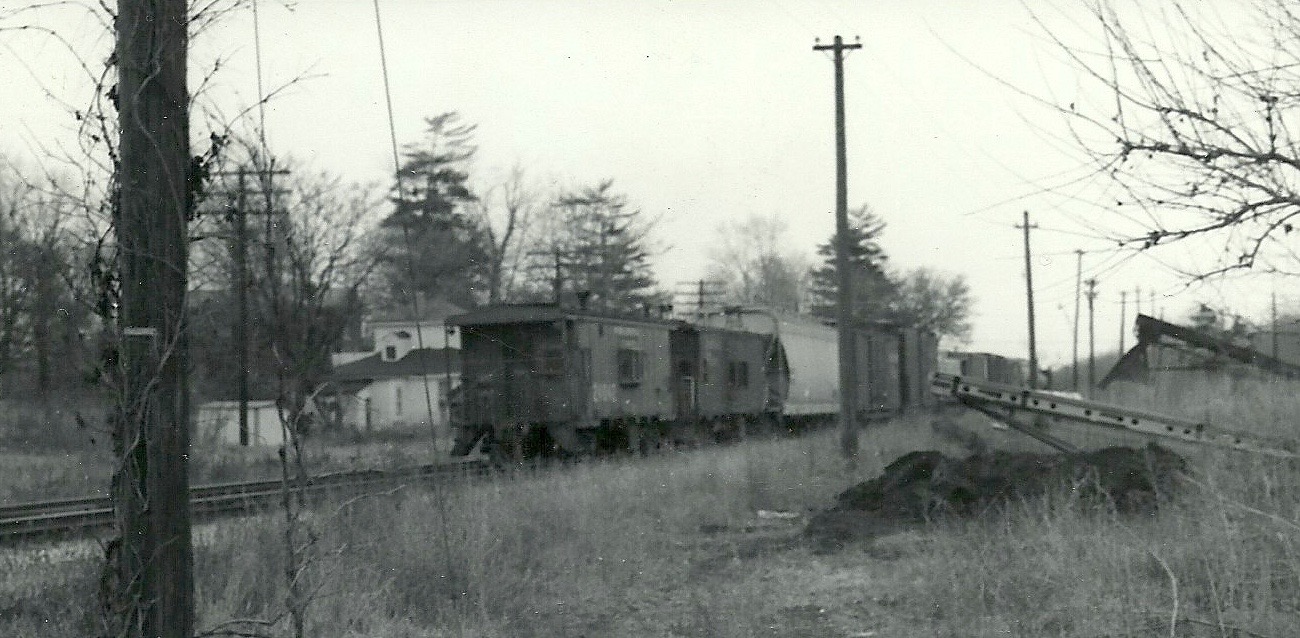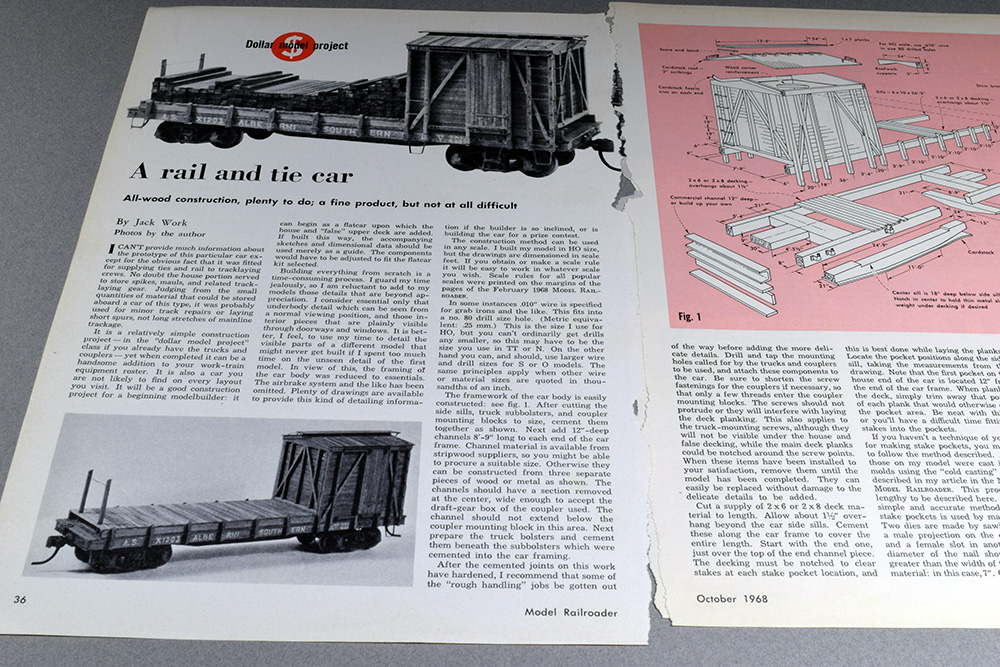
The First Encounter
When I think of trains, memories of sights and sounds that I can’t experience firsthand anymore come flooding back. I recall the joy of watching a train from the window of my childhood home, of being lulled to sleep by the rhythm of wheels hitting a rail joint, of exploring the world within and around a siding across the street from the house.
I remember standing on a bridge watching and feeling a long freight train pull out of the yard just a few feet below me. I remember countless times with my dad watching trains at the depot.

Catching a train in the yard on Sunday mornings could be hit or miss. However, when a long freight crawled westward, the experience was indelible from this vantage point.
As an awkward teenager who didn’t know how or where to fit in, I remember the refuge the craft provided and how it felt like a safe haven while growing up in turbulent times (the late 1960s). I remember reading construction articles that were far beyond my skill level. Those articles weren’t written for an unskilled teenager, yet they provided inspiration and imparted an ethic and view of the craft that still serves me today. They challenged me with skills I didn’t have, yet the authors made it clear that one could have those skills with practice and effort. Those articles inspired a desire to become a better modeler and do work like that. Fifty years later, time spent at the modeling bench or working on the layout is where I feel the most relaxed and at ease with myself.

Articles like this one weren’t aimed at unskilled teenagers like I was then. However, they inspired a desire to become a better modeler who could do work like this.
For many of us this craft provides a deep satisfaction that brings a sense of comfort and order. The craft can provide multiple ways to explore the richness and depth of the world if we take the time to look and understand what’s there. It can reveal a sense of order and beauty hidden amongst the chaos. If we learn to look beneath the surface of things, it can reveal the simplicity that underlies the complex.
We’re not just modeling trains in this work. We model to find satisfaction. We model to express a vision about something we see or have experienced. A craft as mature and nuanced as this one can offer more than a way to fill up a space with the trappings of mindless consumption. If we’re open to the idea, this craft can provide a creative outlet that can not only shape a life but also, speak to one for a lifetime. It’s why I take a different approach.
Regards,
Mike
For me, growing up in Northern California, I was surrounded by history and trains. Ever since I can remember I loved trains and especially the history around them. As an artist I always needed a creative outlet. Model building and painting filled that desire. Model building has become an outlet to tell 3D stories of the daydreams in my head.
I build for myself. It’s my own personal outlet based on stories I love to make up in my head, which have some basis in reality. Each model has a back story and history. That, for me, is so rewarding to see come alive in tangible form.
I think there’s been such an incredible shift in this hobby toward prototype modelling. While well-intended it orders the hobby in a way that prioritizes the possessions over the process. Now that we’re all modelling a particular place on a railroad we’re teased then forced into collecting based on the most efficient way to “get” that thing we “need”. In a way we’re consuming the hobby rather than creating it.
I’ve been contemplating the idea themselves like the articles of spoken language. I believe this to be true when I see a model another modeller presents and we are able to connect – I can correctly hear what they’re saying by only seeing the model and without instruction beyond what the model is. It leaves me wondering how we can communicate through the medium of models or what we are whether we intend to or not? What is the state of my modelling saying about this place I’m in now? How can I use this hobby to tell you about how I’m exploring my identity?
Chris
That opening image in this post is wonderful. I really enjoy just looking at it and imagining the questions that flow from it.
“You only need one caboose. Heck, you might not need any cabooses. Why are there two? That’s a decision a person on the railroad made in the moment to add both cabooses to this train. Are both cabooses working or maybe being delivered? Was this common?”
“Those conveyors in the foreground. Are they active and being used or artifacts left behind as evidence of what we used to do here?”
We might say we’re modelling a specific place and time but every place and time is the sum of everything that happened there leading up to this moment. All the decisions we made. All the opportunities we had. What we did and why we did it.
But now I’m just echoing the rambling conversation I am having with myself as I study that photo. Thank you for including it.
Chris
Chris, your comment takes me to a central question I wrestle with constantly: How do I wrap my head around how people in different locales and eras dealt with, and looked at, the world compared to us in 2021? How do you appropriately populate and detail a past timeframe? How did they arrive at solutions and move through their world? Things that snag our eye were perhaps ordinary to them.
This problem keeps me awake at night because my era of interest is the 1870s-1890s and I want to know how to craft a scene to that environment and not let my 2021 brain override the historic reality. Frankly, the more I study that world beyond the pictures and first hand company documents I realize just how much different people saw and approached their world compared to how I would. Newspapers and other accounts of life beyond the railroads helps close the gap somewhat, but so much is missing.
That extra caboose and those conveyors had a meaning, to someone, but not clearly to me. I get the use, to a certain point, but why place the conveyors there? Are they abandoned? Just sitting till put away? Awaiting the next car? Why a second caboose? The conversations and activities that led up to those decisions were made by sensible people whose context 50 years ago is not the same as ours. They dealt with the problems differently than we would.
To me this, the historic human element/psychology underlaying the scene, is a fascinating aspect of modeling that I just don’t see discussed enough.
Chris, it’s probably why I’m much more trying to model an ambiance nowadays that a purely prototypical place. I no longer see it as a compromise, but rather as my own interpretation and impression based on my recurrent encounters with trains. I’ve come to realize some fictive scenes are closer to my memories than real ones. The universal language of trains and their imagery speak more to me than a particular moment set in a specific date.
I wouldn’t be surprised my first conscious encounter with trains had a lot to do with this. At age three, our cars was stopped at a grade crossing in my village. The locomotive had blocked the road and was unable to move for a few minutes. Its towering presence and deep sound had a serious impact. I never had chance to chase train as a kid of a teenager. Only a few times per year I would have the chance to see them up close, slowing moving through the village under speed restriction, between rows of houses framing them. They were a daily auditive event, but a rare sight, a precious encounter that made them mythic in my mind. Often, people ask me why I don’t own a car… mainly because they never had that mythic impact on me… They are common, wimpy, barely have presence (if not an utterly annoying one) and don’t tell a story spanning worlds far away that I haven’t seen. A grade crossing and a slow moving steel piece of machinery and I’m a happy camper, fast speed on the highway, I don’t care.
Mike, I had the same experience with old magazines describing techniques I barely understood due to lack of skill and the barrier of language. But the impact was tremendous. It opened possibilities and a desire to try. More than 30 years ago, I saw for the first time a Model Railroader magazine at a flea market. I was about 6-7 years old and couldn’t not believe the realism of the cover. “If only I could do that and capture the trains I can rarely see, it would be great” was what I thought. This desire for both emulation and creative independence would have a tremendous effect in my life. I recall when life was hard in teenage years, I would feel down. Instead of destruction, it transformed the bad feeling in a constructive path that led to better days and new dreams. Modelling isn’t very different from the saint Benedict rules “Ora et Labora”. It is an introspective activity that brings together the material world and the meaning of life. It may sound pompous, but this hobby is a synthesis of many different and conflicting things in the pursue of a coherent vision.